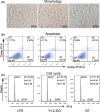CD93 in macrophages: A novel target for atherosclerotic plaque imaging?
- PMID: 35166040
- PMCID: PMC8995462
- DOI: 10.1111/jcmm.17237
CD93 in macrophages: A novel target for atherosclerotic plaque imaging?
Abstract
Noninvasive imaging atherosclerotic (AS) plaque is of great importance for early diagnosis. Recently, CD93 in MΦ was linked to atherosclerosis development. Herein, we have investigated whether CD93 in MΦ is a potential novel target for atherosclerotic plaque imaging. CD93hi and CD93lo MΦ were prepared with or without LPS stimulation, before biological activity was evaluated. A rat AS model was produced with left carotid artery clamped. Whole-body/ex vivo phosphor autoradiography of the artery and biodistribution were investigated after incorporation of 3 H-2-DG into CD93hi and CD93lo MΦ or after 125 I-α-CD93 (125 I-anti-CD93mAb) injection. The plaque tissue was subjected to CD93/CD68 immunofluorescence/immunohistochemistry staining. CD93hi and CD93lo MΦ cells were successfully prepared without significant effect on bioactivity after incorporative labelled with 3 H-2-DG. The AS model was successfully established. Biodistribution studies showed that adoptive transfer of 3 H-2-DG-CD93hi MΦ or 125 I- α-CD93 injection resulted in accumulation of radioactivity within the atherosclerotic plaque in the clamped left carotid artery. T/NT (target/non-target, left/right carotid artery) ratio was higher in the 3 H-2-DG-CD93hi MΦ adoptive transfer group than in the 3 H-2-DG-CD93lo MΦ group (p < .05). Plaque radioactivity in the 125 I-α-CD93 injection group was significantly higher than in the 125 I-IgG control group (p < .01). The higher radioactivity accumulated in the clamped left carotid artery was confirmed by phosphor autoradiography. More importantly, CD93/CD68 double-positive MΦ accumulated at the atherosclerotic plaque in 3 H-2-DG-CD93hi MΦ adoptive transfer group, which correlated with plaque radioactivity (r = .99, p < .01). In summary, both adoptive-transferred 3 H-2-DG-labelled CD93hi MΦ and 125 I-α-CD93 injection specifically targeted CD93 in atherosclerotic plaque. CD93 is a potential target in atherosclerotic plaque imaging.
Keywords: CD93; atherosclerosis; macrophage; molecular imaging; radionuclide.
© 2022 The Authors. Journal of Cellular and Molecular Medicine published by Foundation for Cellular and Molecular Medicine and John Wiley & Sons Ltd.
Conflict of interest statement
The author declares that there is no conflict of interest.
Figures







Similar articles
-
Dual-Modality Activity-Based Probes as Molecular Imaging Agents for Vascular Inflammation.J Nucl Med. 2016 Oct;57(10):1583-1590. doi: 10.2967/jnumed.115.171553. Epub 2016 May 19. J Nucl Med. 2016. PMID: 27199363 Free PMC article.
-
64Cu-Labeled Divalent Cystine Knot Peptide for Imaging Carotid Atherosclerotic Plaques.J Nucl Med. 2015 Jun;56(6):939-44. doi: 10.2967/jnumed.115.155176. Epub 2015 Apr 23. J Nucl Med. 2015. PMID: 25908832
-
In vivo molecular imaging of atherosclerotic lesions in ApoE-/- mice using VCAM-1-specific, 99mTc-labeled peptidic sequences.J Nucl Med. 2013 Aug;54(8):1442-9. doi: 10.2967/jnumed.112.115675. Epub 2013 May 29. J Nucl Med. 2013. PMID: 23719858 Free PMC article.
-
Vulnerable atherosclerotic plaque - a review of current concepts and advanced imaging.Biomed Pap Med Fac Univ Palacky Olomouc Czech Repub. 2018 Mar;162(1):10-17. doi: 10.5507/bp.2018.004. Epub 2018 Feb 21. Biomed Pap Med Fac Univ Palacky Olomouc Czech Repub. 2018. PMID: 29467545 Review.
-
Nanoparticle uptake by macrophages in vulnerable plaques for atherosclerosis diagnosis.J Biophotonics. 2015 Nov;8(11-12):871-83. doi: 10.1002/jbio.201500114. Epub 2015 Jun 25. J Biophotonics. 2015. PMID: 26110589 Review.
Cited by
-
Diagnostic and Prognostic Role of CD93 in Cardiovascular Disease: A Systematic Review.Biomolecules. 2023 May 30;13(6):910. doi: 10.3390/biom13060910. Biomolecules. 2023. PMID: 37371490 Free PMC article.
-
Vsig4+ resident single-Kupffer cells improve hepatic inflammation and fibrosis in NASH.Inflamm Res. 2023 Apr;72(4):669-682. doi: 10.1007/s00011-023-01696-1. Epub 2023 Feb 6. Inflamm Res. 2023. PMID: 36745210
-
[Relationship of cerebrospinal fluid and serum levels of SIL-2R, eNOS, and CD93 with the progression and prognosis of viral encephalitis in children].Zhongguo Dang Dai Er Ke Za Zhi. 2024 Oct 15;26(10):1072-1077. doi: 10.7499/j.issn.1008-8830.2405043. Zhongguo Dang Dai Er Ke Za Zhi. 2024. PMID: 39467677 Free PMC article. Chinese.
-
The SELP, CD93, IL2RG, and VAV1 Genes Associated with Atherosclerosis May Be Potential Diagnostic Biomarkers for Psoriasis.J Inflamm Res. 2023 Feb 27;16:827-843. doi: 10.2147/JIR.S398862. eCollection 2023. J Inflamm Res. 2023. PMID: 36876153 Free PMC article.
-
Perspectives in the Diagnosis, Clinical Impact, and Management of the Vulnerable Plaque.J Clin Med. 2025 Feb 25;14(5):1539. doi: 10.3390/jcm14051539. J Clin Med. 2025. PMID: 40095464 Free PMC article. Review.
References
-
- Finn AV, Nakano M, Narula J, Kolodgie FD, Virmani R. Concept of vulnerable/unstable plaque. Arterioscler Thromb Vasc Biol. 2010. Jul;30(7):1282‐1292. - PubMed
-
- Liu C, Zhang X, Song Y, et al. SPECT and fluorescence imaging of vulnerable atherosclerotic plaque with a vascular cell adhesion molecule 1 single‐chain antibody fragment. Atherosclerosis. 2016. Nov;254:263‐270. - PubMed
-
- Raggi P, Achenbach S. Computed tomography for atherosclerosis and coronary artery disease imaging. Discov Med. 2010. Feb;9(45):98‐104. - PubMed
-
- Jager NA, Westra J, Golestani R, et al. Folate receptor‐β imaging using 99mTc‐folate to explore distribution of polarized macrophage populations in human atherosclerotic plaque. J Nucl Med. 2014. Dec;55(12):1945‐1951. - PubMed
Publication types
MeSH terms
Grants and funding
LinkOut - more resources
Full Text Sources
Medical
Research Materials
Miscellaneous

